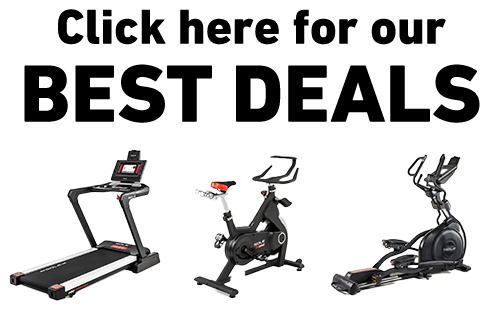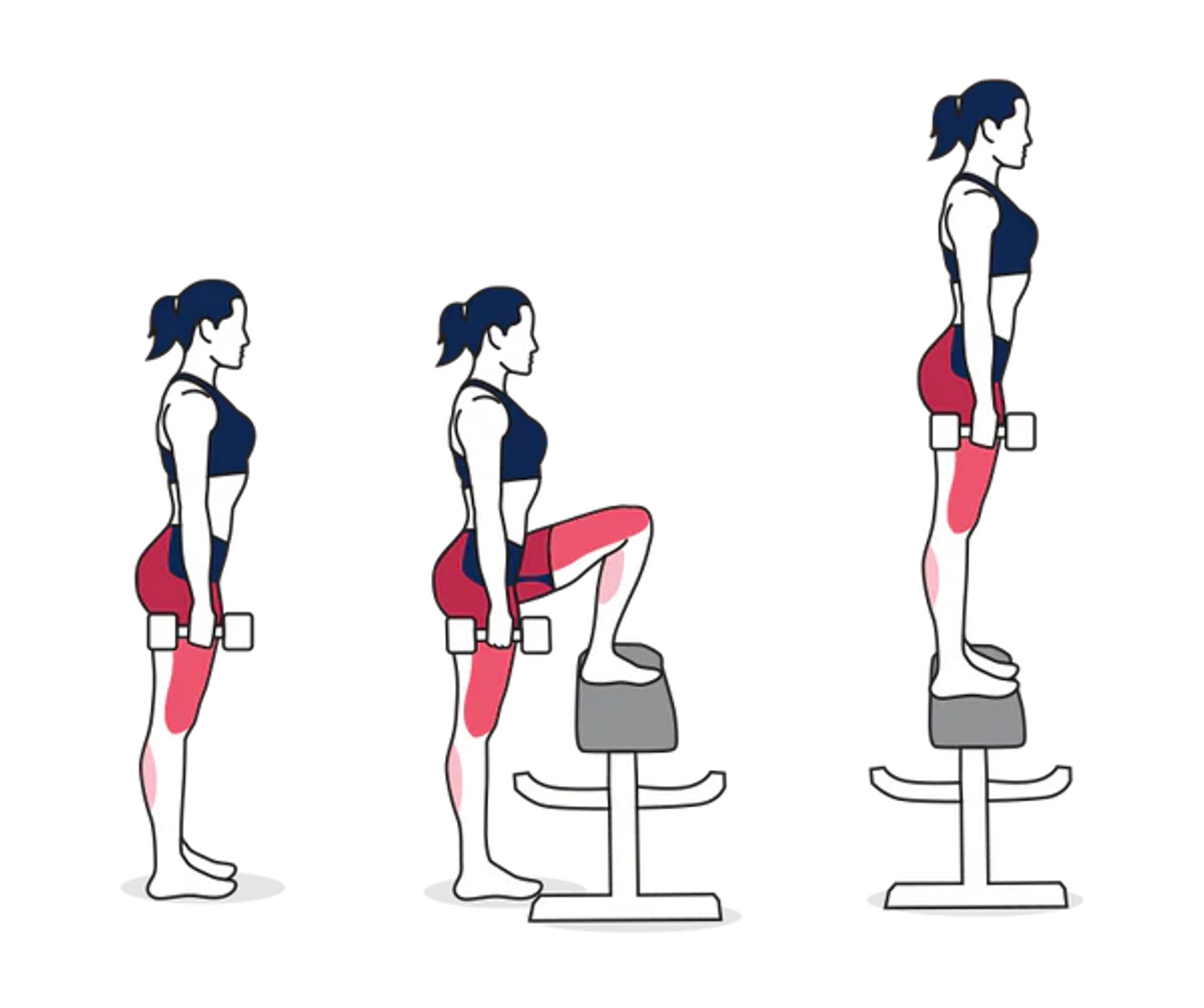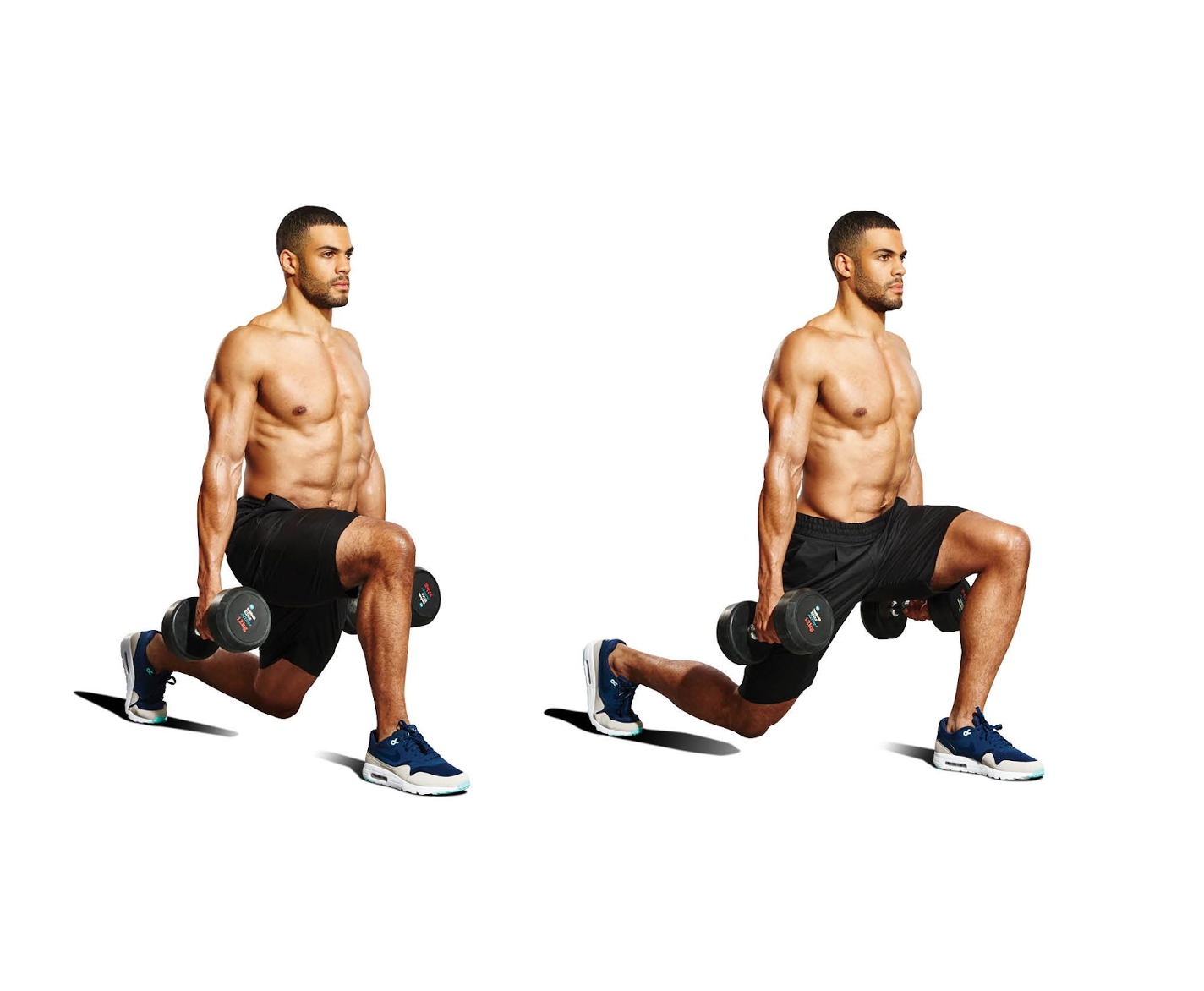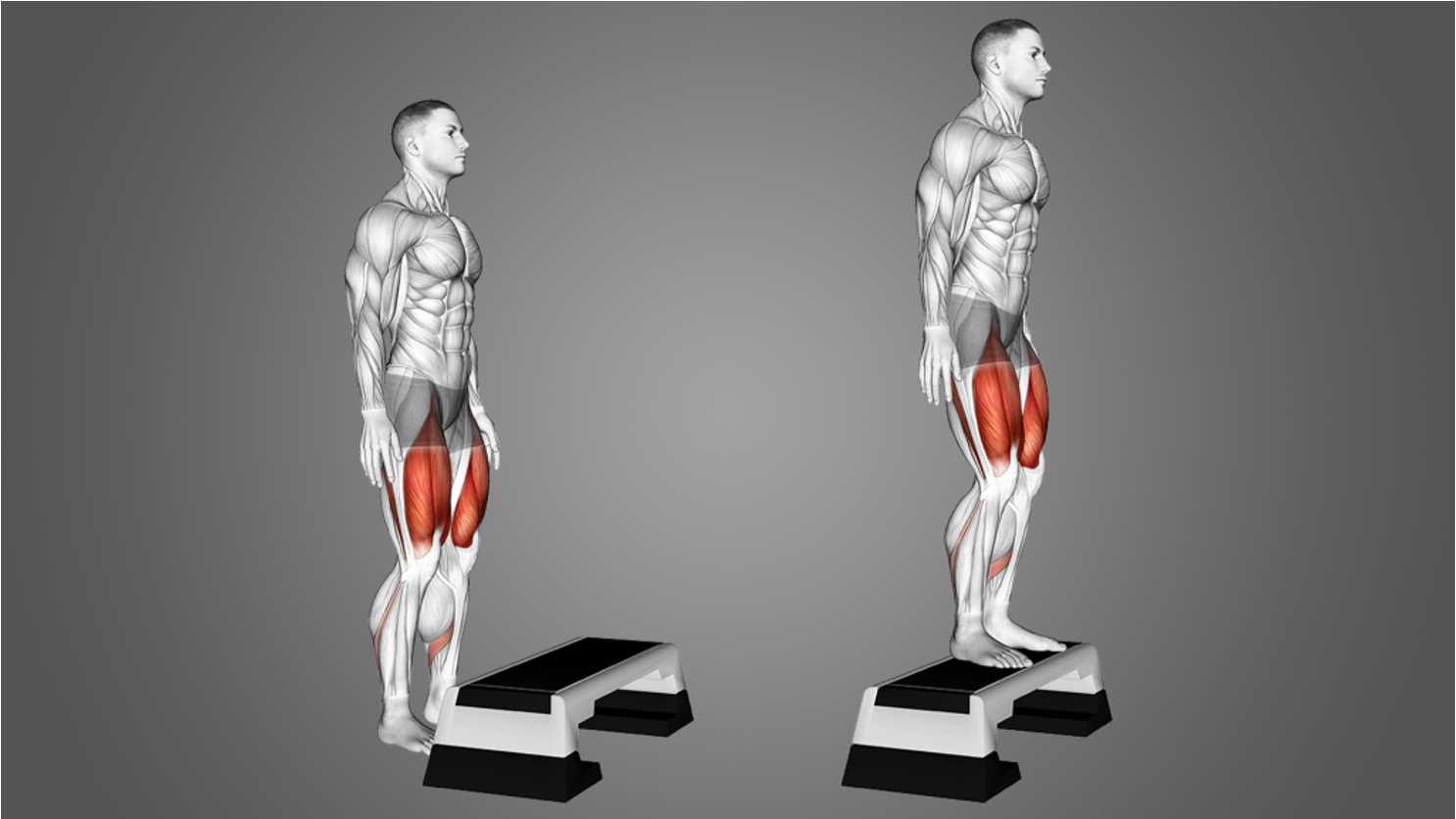Key Takeaways
- Step ups are great for functional strength and work multiple muscles at once, perfect for athletes and those focused on everyday movement patterns.
- Hip thrusts are the king of glute exercises; research shows they beat squats and deadlifts for glute activation.
- For the best results, do both - step ups for functional strength, hip thrusts for glute growth
- Form matters big time; common mistakes include wobbly knees on step ups and arching your back on hip thrusts.
- SOLE adjustable dumbbells and Olympic barbell provide ideal loading options for both exercises—use the dumbbells for step ups to address leg imbalances, then load up the barbell for heavy hip thrusts to maximize glute development.
Choosing Between Step Ups and Hip Thrusts
The step up and hip thrust are two fundamentally different movement patterns that challenge your lower body in distinct ways.
Step ups are a unilateral, functional exercise that mimics the everyday movement of climbing stairs while demanding balance and coordination. Hip thrusts are a horizontal hip extension exercise that places maximum tension on the glutes through a full range of motion while minimizing stress on the lower back. Your choice between these exercises should align with your specific training objectives, whether that's athletic performance, aesthetic development, or rehabilitation needs.
Both exercises have earned their place in training programs, but they shine in different scenarios. Step ups tend to be more metabolically demanding due to their standing, dynamic nature, while hip thrusts allow for greater loading potential specifically on the glute muscles.
Many experienced lifters find that alternating between these movements throughout their training cycles provides complementary benefits that address both functional strength and targeted muscle development.
|
At SOLE, we're proud to offer top-quality exercise equipment designed for home and gym use. Our machines are built to meet the highest standards of durability and performance, making them ideal for fitness enthusiasts at any level. SOLE Products
|
Step Ups: Muscles Activated
Step ups are like the Swiss Army knife of leg exercises. You're not just working one muscle—you're hitting everything from your feet to your core. This multi-joint movement pattern makes step ups effective for developing coordinated strength that transfers to real-world activities and athletic movements.
The height of your step directly influences which muscles receive the greatest emphasis. Lower step heights tend to focus more on the quadriceps, while higher steps increase the demand on the glutes and hamstrings. (Image courtesy of Inspire US)
Quadriceps
The quadriceps serve as primary movers during step ups, especially during the concentric (upward) phase of the movement. These four muscles along the front of your thigh—the rectus femoris, vastus lateralis, vastus medialis, and vastus intermedius—work together to extend your knee as you drive upward onto the platform.
Glutes
Step ups are effective for glute activation, with research showing they may actually outperform hip thrusts for gluteus maximus engagement in some individuals. The gluteus maximus fires powerfully as you extend your hip to raise your body onto the step, particularly when you focus on driving through your heel and fully extending your hip at the top of the movement.
The unilateral nature of step ups also forces your gluteus medius and minimus to stabilize your pelvis throughout the movement, preventing excessive hip drop and reinforcing proper movement patterns.
Hamstrings
Your hamstrings pull double duty during step ups. They help extend your hip (hip extensors) and control your knee (knee flexors). They really kick in when you lower yourself back down, keeping you from collapsing. Want more hamstring work? Use a higher step.
Calves
Your calves might not be the stars here, but they're definitely working. The gastrocnemius and soleus help stabilize your ankle and give you that final push at the top. Over a full set, that adds up to solid calf work. The plantarflexion that occurs as you complete the step up engages these muscles, especially when you fully extend through your ankle at the top of the movement.
Core Stabilizers
Step ups force your core to work hard just to keep you upright. Your abs, obliques, and lower back muscles fire constantly to stop you from tipping over or twisting. Add weight, and your core has to work even harder.
The anti-rotation demands make step ups awesome for building core strength that actually helps in daily life. Your core never gets a break; it's on duty for every single rep.
Hip Thrust Muscle Engagement
Hip thrusts changed the game for glute training. Unlike squats and deadlifts that compress your spine, hip thrusts create horizontal force that hammers your glutes without beating up your back. (Image courtesy of Hertfordshire Sports Village)
Gluteus Maximus
Your glute max is the MVP during hip thrusts; no other exercise lights it up quite like this. EMG studies prove hip thrusts activate your glutes way more than squats, deadlifts, or pretty much anything else.
What makes hip thrusts special? Your glutes work hardest when your hips are fully extended, exactly where hip thrusts put the most tension. You can load up serious weight right where your glutes are strongest.
Hamstrings
Your hamstrings help out during hip thrusts, but they're more like the supporting cast than the lead actor. They assist with hip extension, especially when you drive through your heels and squeeze at the top.
If you want more hamstring action, put your feet a bit farther from your butt. Bring them closer, and your quads take over more. Play around with your foot position to hit what you need.
Quadriceps
Hip thrusts aren't a quad exercise, but your quads still do some work. They help extend your knees as you thrust up, especially with closer foot placement. If your knees bug you, hip thrusts often feel way better than squats while still giving your quads something to do.
Core
Don't think that hip thrusts are just a glute exercise; your core works hard too. Your abs and obliques have to lock down to keep your back from arching as you thrust up. The heavier you go, the more your core has to work.
The bracing you learn from hip thrusts carries over to other lifts too. Master that intra-abdominal pressure during hip thrusts, and your squats and deadlifts will thank you.
Hip Flexors
Your hip flexors control the descent as you lower back down. They might not be prime movers, but they keep things smooth and controlled. If you sit all day and have tight hip flexors, hip thrusts can help you strengthen your backside while your front side gets a gentle stretch.
Step Up Benefits
Step ups boost athletic performance, help with everyday movements, and build serious lower body strength. Do them right and consistently, and they'll transform your legs in ways other exercises can't touch. (Image courtesy of Inspire US)
Functional Strength
Step ups mirror real life. Every time you climb stairs, hike a trail, or hop onto something, you're basically doing a step up. This direct transfer to daily activities makes them gold for improving how you move and keeping you strong as you age.
Athletes love step ups because they're so similar to jumping, cutting, and accelerating. The single-leg strength you build transfers straight to the field or court. That's why strength coaches make athletes do tons of step ups; they bridge the gap between gym strength and game-day performance.
The injury prevention aspect is huge too. Stronger muscles in the right movement patterns mean less chance of getting hurt doing normal stuff. Step ups build balanced strength around your knees and hips, making your joints more stable and resilient.
Balance Improvement
Step ups challenge your balance like crazy. When you shift from two feet to one, your nervous system goes into overdrive trying to keep you stable. All those little stabilizer muscles around your ankles, knees, and hips get a serious workout.
Your body's sense of where it is in space (proprioception) gets better too. This improved awareness helps with coordination in everything else you do and cuts your fall risk, so they’re super important as you get older. Regular step ups basically train your nervous system to react faster when you're off balance.
Want to make balance even harder? Try higher steps, add weight, or use a slightly unstable surface. Each progression forces your body to adapt and get even better at staying stable.
Unilateral Development
Step ups reveal the truth about your strength imbalances. By working each leg solo, you can't let your strong side cover for your weak side. This leads to more balanced development, which looks better and keeps you healthier.
Cardio Component
Step ups jack up your heart rate way more than most strength exercises. You get muscle building and cardio in one shot, so they’re super efficient if you're short on time. Even moderate-pace step ups can push your heart rate to 70–80% of max.
Crank up the reps or do them in a circuit, and the cardio effect goes through the roof. One study found that 3 sets of 20 step ups gave similar cardio benefits to moderate treadmill running, plus you build leg strength.
For fat loss, step ups rock. You burn calories during the workout, plus the muscle work boosts your metabolism for hours after. They’re way better than doing isolation exercises if you want to lean out.
Hip Thrust Advantages
Hip thrusts changed glute training for good by loading your muscles horizontally instead of vertically. No spine compression, maximum glute work. That's why everyone from powerlifters to bikini competitors uses them.
Glute Isolation
Hip thrusts isolate your glutes better than pretty much any other exercise. The horizontal force hits your glutes right where they're strongest. Add heavy weight to that perfect angle, and you've got the ultimate recipe for glute growth.
Progressive Overload
Hip thrusts let you add weight like crazy. Most people can hip thrust way more than they squat or deadlift, often 2–3 times bodyweight once they get strong. All that weight goes straight to your glutes, creating massive growth potential.
Posterior Chain Focus
Hip thrusts hammer your entire backside, like your glutes, hamstrings, and lower back, without stressing your knees or spine. They’re perfect if you've got old injuries but still want to get strong. They also help fix the quad-dominant imbalances most people get from sitting too much.
Athletes see huge performance gains from hip thrusts. Sprint speed, jump height, and power all improve when you build a stronger posterior chain. The horizontal hip drive directly transfers to athletic movements.
Minimal Equipment
While barbell hip thrusts have become the standard variation in many gyms, effective hip thrust training can be accomplished with minimal equipment. You can do effective hip thrusts almost anywhere. Start with just bodyweight, then add bands, dumbbells, or whatever weight you have. This flexibility means you can stay consistent whether you're at home, traveling, or in a packed gym.
Proper Hip Thrust Execution
Setup Position
Set your upper back against a bench, shoulders just below the edge. Position your feet so your shins are vertical at the top, usually about shoulder-width apart. Keep your core tight and chin tucked throughout.
Movement Pattern
Drive through your heels to thrust your hips up until you form a straight line from shoulders to knees. Squeeze your glutes hard at the top, that's where the magic happens. Lower with control, keeping tension on your glutes the whole time.
Form Fixes
Stop arching your back, that's the biggest mistake people make. Keep your ribs down and core tight. Drive through your heels, not your toes. Make sure you actually extend your hips fully at the top. And please, use a pad on the bar unless you enjoy hip bruises.
When to Choose Each Exercise
Pick based on your goals, fitness level, and any injuries you're dealing with. Both exercises rock, but they shine in different situations. Know when to use each one, and you'll maximize your results. (Image courtesy of self.com)
Athletic Performance Goals
Athletes who need explosive power, speed, or jumping usually get more from hip thrusts. The glute power and horizontal force production translate directly to sprinting and jumping. Research backs this up: hip thrust strength correlates strongly with sprint speed.
But if your sport involves lots of single-leg movements (like basketball, soccer, or running), step ups might serve you better. They build the unilateral strength, balance, and coordination you need on the field. Many coaches use both, hip thrusts for max strength phases, step ups for sport-specific prep.
Aesthetics Focus
Want a better butt? Hip thrusts are your best friend. The isolation, heavy loading, and constant tension create the perfect storm for glute growth. Most physique-focused programs make hip thrusts a cornerstone exercise, done 1–2 times per week with steady weight increases.
Injury Considerations
If you got cranky knees, hip thrusts are way easier on your joints while still building lower body strength. Bad back? Step ups might feel better since they don't load your spine like weighted hip thrusts do. Start light with either exercise if you've been hurt before, and maybe check with a PT for personalized advice.
Combining Both Exercises
For the best lower body development, do both. Maybe hip thrusts on your heavy lower body day for max glute growth, then step ups on another day for functional strength and balance. This combo hits everything: max strength, single-leg stability, real-world movement patterns, and targeted muscle growth. You get the complete package instead of leaving gaps in your training.
Level Up Your Lower Body Training with SOLE's Versatile Equipment
Ready to build stronger glutes and legs without fighting for equipment at crowded gyms? SOLE premium strength equipment makes both step ups and hip thrusts more effective at home.
Our SW155 and the SW180 Adjustable Dumbbells are perfect for step ups. Their balanced weight distribution keeps you stable during those single-leg challenges, while the quick-adjust system lets you dial in different weights for each leg if you've got imbalances to fix.
For hip thrusts, the SW111 Olympic Barbell is your ticket to serious glute gains. Its 194,000 PSI tensile strength handles the heavy loads you'll be pushing as you get stronger, so you'll progress fast on hip thrusts. The specialized knurling keeps the bar from rolling down your hips during sets, letting you focus on that glute squeeze instead of fighting with equipment.
What's genius about SOLE's setup is how seamlessly you can switch between exercises. Start with weighted step ups using the adjustable dumbbells, then transition to barbell hip thrusts without wasting time changing plates or hunting for equipment. The SW116 Weight Bench provides the perfect height for hip thrust setup, with commercial-grade padding that won't compress under heavy loads.
Don't forget the SOLE Equipment Mat! It gives you a defined, non-slip surface for step ups while protecting your floors during heavy hip thrusts. Plus, the cushioning makes floor-based glute bridges more comfortable as you warm up.
The SOLE+ App guides you through proper form for both movements, showing exactly how to progress from bodyweight to loaded variations. You'll learn the technique cues that maximize muscle activation and avoid common mistakes that limit results.
Ready to transform your lower body? Check out the SOLE strength collection today!
Frequently Asked Questions (FAQs)
Which exercise builds bigger glutes faster?
Hip thrusts usually win for pure glute size. Research consistently shows they activate glutes more than almost any other exercise. The targeted stimulation plus heavy loading creates perfect conditions for growth.
Don't write off step ups though, especially with higher steps (at or above knee height). A 2018 study found high step ups seriously increased glute activation. For best results, use both—hip thrusts as your main glute builder, step ups as a solid complement.
Can beginners safely perform step ups and hip thrusts?
Both exercises are suitable for beginners when properly scaled to current fitness levels. For step ups, beginners should start with a lower step height (8–12 inches) and master the bodyweight version before adding external loads.
For hip thrusts, beginners can start with glute bridges (performed with shoulders on the floor rather than elevated) to learn proper hip extension patterns. Once comfortable, progress to bodyweight hip thrusts with shoulders elevated on a bench, focusing on achieving full hip extension and gluteal contraction at the top position.
How often should I include these exercises in my routine?
For optimal results, perform each exercise 1–2 times weekly, allowing 48–72 hours between sessions targeting the same movement pattern. The frequency can be adjusted based on your recovery capacity, overall training volume, and specific goals.
Higher frequency (twice weekly) may be beneficial during periods focused on technique mastery or when using moderate loads, while lower frequency with higher intensity may be more appropriate during strength-focused phases.
Do I need special equipment for effective results?
Step ups require minimal equipment, just a sturdy elevated surface of appropriate height. While specialized plyometric boxes are ideal, a sturdy bench, stair, or even a stack of weight plates can work effectively. For hip thrusts, while bodyweight versions provide some benefit, significant progress requires external loading. A barbell with sufficient weight plates and a cushioning pad (or specialized hip thrust pad) is the ideal setup, though resistance bands, dumbbells, or weighted chains can serve as alternatives for home training or beginners.
What SOLE equipment setup works best for step ups and hip thrusts?
For the ultimate lower body setup, grab the SW180 Adjustable Dumbbells for step ups and the SW111 Olympic Barbell for hip thrusts. The adjustable dumbbells let you nail those step ups with perfect weight for each leg (super important if one side's weaker), while the barbell lets you load up serious weight for hip thrusts as you get stronger.
Most people can hip thrust way more than they can hold in their hands, so the barbell becomes essential pretty quick. The SW116 Weight Bench works perfectly for hip thrust setup, just the right height and sturdy enough for those heavy sets.




Leave a comment
This site is protected by hCaptcha and the hCaptcha Privacy Policy and Terms of Service apply.